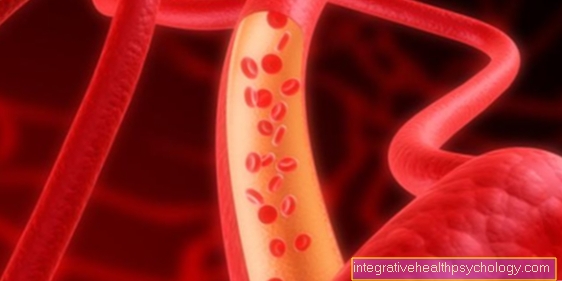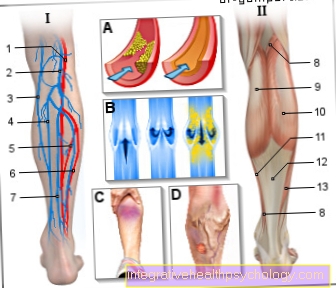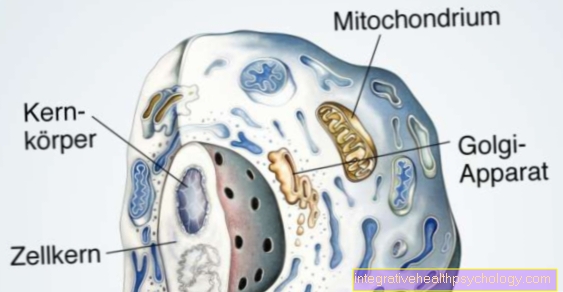Collagenosis
definition
The term “collagenoses” describes a group of diseases of autoimmune origin. This means that the person's immune system triggers a defense reaction against the body's own cells.
In the case of collagenoses, this defense reaction is directed against cells of the connective tissue. Since connective tissue is found everywhere in the body, practically any organ can be affected. Often there are skin symptoms and joint problems.
Read more under: Autoimmune Disease - What is it?

causes
It is not known why autoimmune diseases develop.
Usually the body's defense system is used to identify and eliminate foreign cells. In the case of autoimmune diseases, this defense reaction is directed against the body's own cells. In the case of polymyositis and dermatomyositis, which belong to the collagenoses, a paraneoplatic (i.e. tumor-related) or a viral genesis is discussed. However, these theories have not yet been finally clarified.
Once the immune system has started to trigger an immune response, an inflammatory reaction occurs. If, as is the case with collagenoses, cells of the connective tissue are attacked, for example, inflammatory cells migrate there and, in the long term, fibrotic remodeling occurs. You can imagine this remodeling like a scar in a place that was previously damaged. Since the “scar tissue” is no longer the original tissue of the organ, such a remodeling is associated with a loss of function, depending on the extent.
Diagnosis
The diagnosis is based on the clinical appearance and a laboratory examination. Since there are various diseases that belong to the collagenosis, the diagnosis of “collagenosis” is not made, but that of the respective disease. The following clinical pictures belong to the collagenoses:
- Lupus erythematosus
- Polymyositis and dermatomyositis
- Scleroderma
- Sjogren's syndrome
In the laboratory test, specific antibodies are detected in the blood, so-called antinuclear antibodies (ANA).
Symptoms
Depending on the illness, the symptoms can present themselves differently (read the corresponding article for the respective illness, see above). However, the collagenoses have some clinical symptoms in common. General symptoms such as fever and weight loss may occur. Collagenoses are often associated with joint problems and muscle inflammation. Skin symptoms are also common. One of them is the so-called Raynaud's syndrome, a circulatory disorder in the hands. When it is cold, the fingers first turn white, then blue and then red.
You can find out more at: Raynaud's Syndrome
Since the connective tissue is attacked in collagenoses, any organ can be affected by the disease. For example, inflammation of the pericardium, known as pericarditis, can occur. If the lungs are affected, the lung membrane can become inflamed. This is known as pleurisy. If the inflammation persists for a long time, pulmonary fibrosis can develop. The kidneys or brain can also be affected by the inflammation.
therapy
The principle of the therapy is to alleviate the symptoms of inflammation and suppress the immune system. There is no causal treatment that eliminates the cause of the disease. There are also a number of general measures that can contain the complaints. This includes avoiding the cold in the presence of Raynaud's syndrome, the consistent implementation of physiotherapy and accompanying psychotherapeutic treatment.
Anti-inflammatory drugs from the group of NSAIDs, including ibuprofen, can be used against the inflammation. Another frequently used group of drugs are the glucocorticoids, which are used in numerous autoimmune diseases because they have an immunosuppressive effect. Other drugs that modulate the immune system include azathioprine and methotrexate.
Read more about the drug group here Immunosuppressants
Duration and forecast
The collagenoses are chronic diseases for which no causal therapy is currently available. With some collagenoses, the disease can come to a standstill on its own, but the self-healing tendency is usually rather low. The disease often progresses slowly, so that the level of suffering for those affected is tolerable for a long time. The prognosis depends on the severity and location of the damage. In particular, the expression in the organs lungs, heart and kidneys play a decisive role in the course of the disease. If they are affected late or only slightly, the prognosis is significantly better than in the case of a severe disease manifestation in these organs.
Course of disease
The course of the disease is very variable. Most collagen diseases manifest in middle adulthood. In many cases the symptoms only increase very gradually. It may be that some collagenoses are only noticeable through skin symptoms. However, a systemic course is also possible, which requires more aggressive immunosuppressive therapy. The course of the disease depends on the condition of the affected organs. If vital organs such as the kidneys, heart or lungs undergo severe fibrotic remodeling, the function of these organs can rapidly deteriorate. If the joints and skin are the main places of manifestation, many of those affected can lead a largely unrestricted life with appropriate therapy. However, no general statement can be made about the course, since the collagenoses can produce a very variable picture of symptoms.
How contagious is that?
There is no risk of infection with collagenosis. Polymyositis and dermatomyositis are suspected of having a viral origin of the disease through a Coxsackie virus infection. Viral diseases are often contagious. However, infection with the virus does not mean that the clinical picture of collagenosis develops from it. It is believed that the immune system is improperly “shaped” by the virus, causing it to attack the body's own cells. How this happens in individual cases has not yet been adequately researched.





























